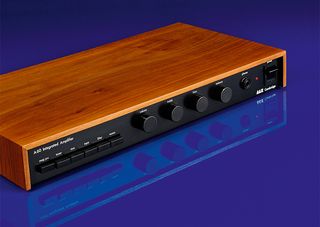In 2016 What Hi-Fi? celebrated its 40th anniversary, and to mark the occasion we picked our 40 most influential products from those four decades. Starting with the year the publication was born (1976), this list features the very best hi-fi of the 1970s.
We then continue our celebratory journey through the '80s, '90s, noughties and 2010s in the articles you'll see below. A new product is added to our Hall of Fame every year at the What Hi-Fi? Awards, so when this year's rolls around we'll be starting our 2020s list too...
- The What Hi-Fi? Hall of Fame: 1980s
- The What Hi-Fi? Hall of Fame: 1990s
- The What Hi-Fi? Hall of Fame: 2000s
- The What Hi-Fi? Hall of Fame: 2010s
- The What Hi-Fi? Hall of Fame: 2020s
Linn LP12 (1976)

The Linn LP12 is arguably the most popular high-end turntable of all time - in the UK, at least.
Introduced in 1972, it went on to dominate the premium turntable market for decades afterwards. Linn made a range of compatible arms and cartridges too, so upgrading was easy.
The deck was well built and superbly engineered, but the company has never stopped developing it.
Just about every aspect of the design, from the suspension to the power supply, has been revised over the years, leading to a string of incremental performance gains.
Early LP12s had a rounded, rich balance that was still lively enough to entertain. Later versions have moved towards neutrality, enjoying greater precision and insight as a result.
Technics SL1200 (1976)

We have a confession. We’ve never considered the SL1200, or any of its subsequent variants, class-leaders when it comes to sound quality. But that doesn’t mean we don’t admire them, or that we don’t badly want to own one of the originals.
Every version we’ve ever tested was built brilliantly – solid and beautifully engineered. This was one of the main reasons they were so successful with DJs across the globe.
They’re easy to use too, with plenty of flexibility when it comes to positioning and cartridge-matching.
We love these decks because they’re tough and fuss-free. With a bit of effort, they’re upgradable too - but they sound good enough as standard to be enjoyable.
Flawless? Definitely not, but that doesn’t stop the SL1200 (in any of its forms) being considered a true classic.
Acoustic Research AR18 (1978)

Back in the 1970s, Acoustic Research was one of the biggest hi-fi brands around. It made a massive impact with its original turntable, but these rather ordinary-looking standmounters are what we remember the most.
In most respects they were considered a basic design even at the time. They were a two-way, sealed box design using a 20cm paper cone mid/bass and a rather unrefined 32mm tweeter.
Yet Acoustic Research took this rather standards recipe and turned out one of the finest budget speakers in history. The AR18s sounded lively and entertaining, but most of all they were fun.
Sure, the treble could have been sweeter and their transparency barely justified the description, but play some music through them and all is forgiven.
NAD 3020 (1978)

The NAD brand is based on the foundations laid by the 3020 amplifier. To date, nothing else the brand has done has made the impact of this slightly flimsy budget box.
Even back then, a power output of around 20W per channel wasn’t particularly impressive - but, in use, this integrated amp could drive speakers more effectively than just about any rival.
Its smooth, full-bodied balance worked brilliantly with the less-than-refined budget kit of the day, delivering sound with unmistakable grace.
Current amplifiers may be ahead where transparency and build quality are concerned, but find one of these in working order and it will still be a joy to listen to.
Rega Planar 3 (1978)

We doubt there has ever been a more dominant turntable than Rega’s Planar 3. Ever since its introduction in 1978, it has been the go-to middle-market record player, and little has changed in the subsequent years.
The various iterations of this deck have won our sub-thousand pound turntable Award so many times we’ve lost count.
What’s the Planar 3’s secret? It’s a simple, well-made design based on sensible engineering principles. Sure, the company has refined just about every component over time, most notably the introduction of the then revolutionary RB300 arm in 1983.
But in essence, the Planar 3 remains what it has always been: a fuss-free performer that makes our records sound great.
A&R Cambridge A60 (1979)

If NAD was the king of the budget amps, then the A60 is what you bought when you wanted to upgrade. The A60 was the first product from A&R Cambridge, which later morphed into Arcam. And what a monster hit it was.
Look past the unassuming appearance and you’ll find a product that combined sensible features, solid build and class-leading sound quality.
The A60 was an easy-going and refined performer. It sounded good with a wide range of recordings and partnering kit.
This wooden-cased unit was as engaging as they come, and it delivered music with a wonderful combination of finesse, rhythmic talent and dynamic subtlety.
Sony Walkman (1979)

At first it seemed like a bit of a niche idea: a portable cassette player, supplied with lightweight headphones. Would people want to listen to music on the move? The answer to that question seems obvious today, but back then there were doubts.
As it happened, the Walkman was a king-size hit for Sony. There were plenty of models, ranging from budget right through to the premium-priced WM-D6C - better known as the Walkman Professional.
This unit sounded good enough to rival some of the best domestic cassette decks around, but could still (just about) fit into your pocket.
The death of cassette led to Sony using the Walkman name on other portable products, but none of these made the same impact on the market as those portable tape machines. That said, they're still winning What Hi-Fi? Awards...
MORE:
